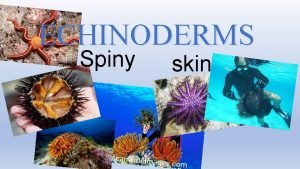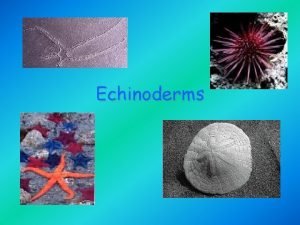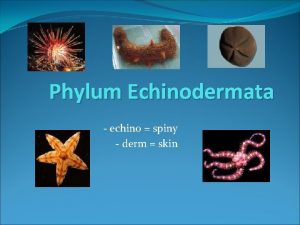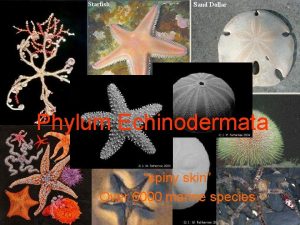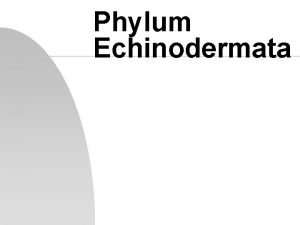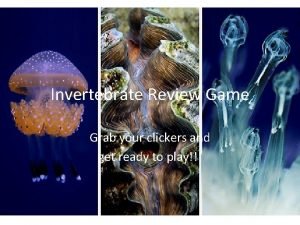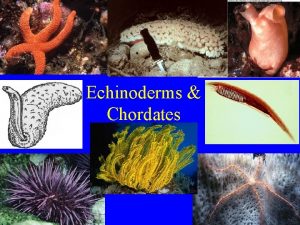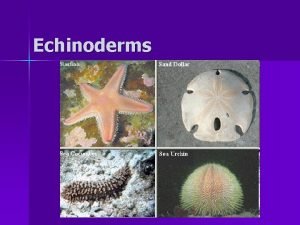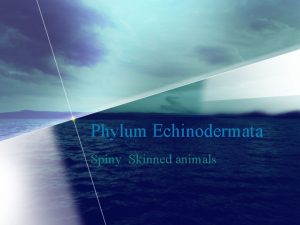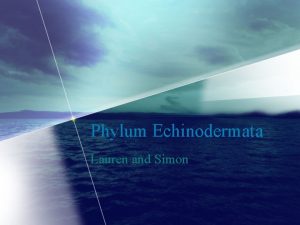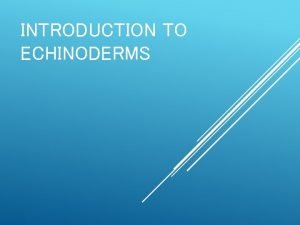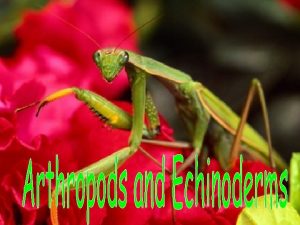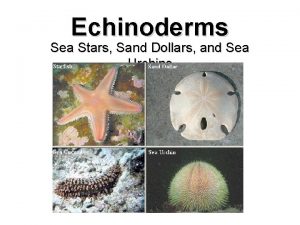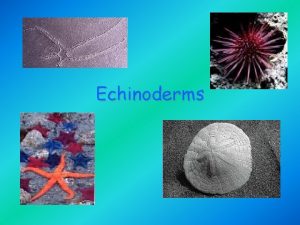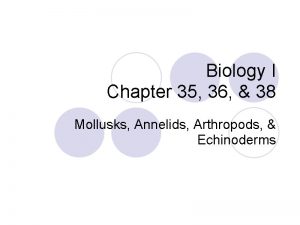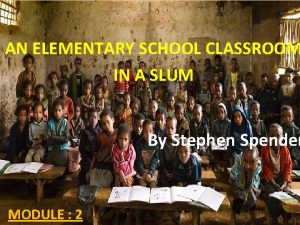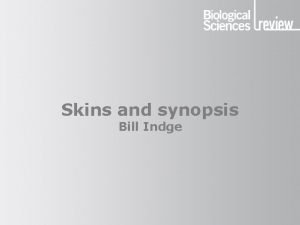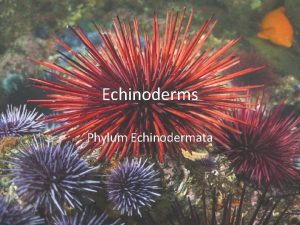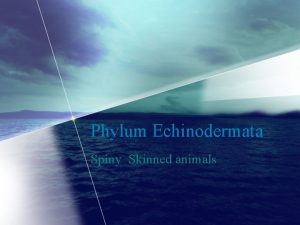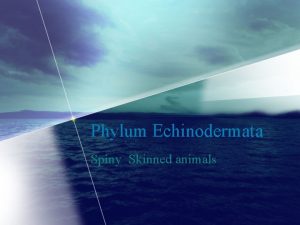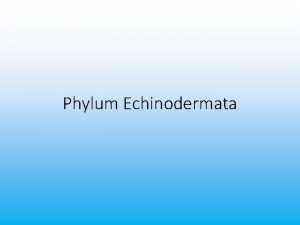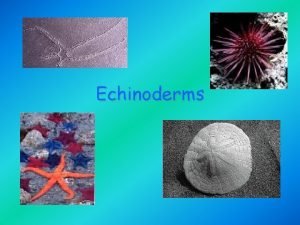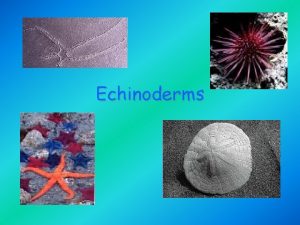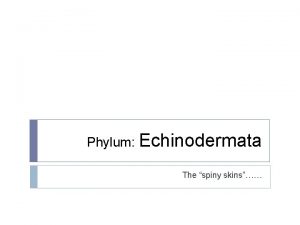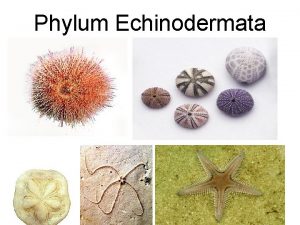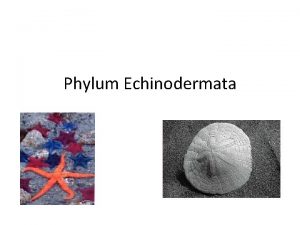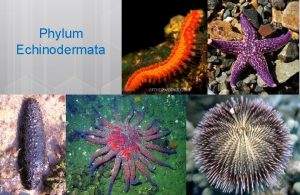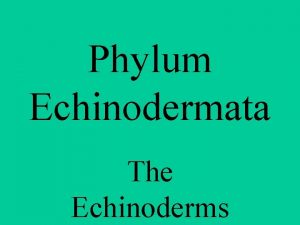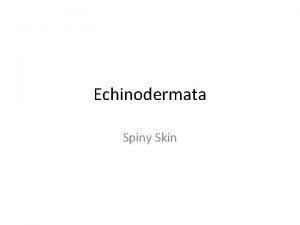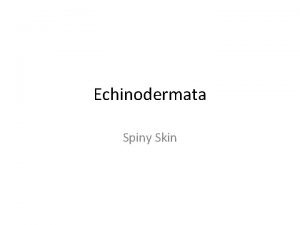Phylum Echinodermata Echinoderms Spiny Skins Do we have




















- Slides: 20

Phylum Echinodermata: Echinoderms “Spiny Skins”

Do we have organisms from the Phylum Echinodermata in our tanks?

Echinoderms Main Characteristics • There are more than 5000 species of Echinoderms • They have exoskeletons and they are musculoskeletal • They have penta-radial symmetry. • They have tube feet • They have water vascular systems • They are benthic organisms

Types of Echinoderms

How many classes do you think Phylum Echinodermata has?

5 Classes of Echinodermata • Asteroidea • Ophiuroidea • Echinoidea • Holothuroidea • Crinoidea Which Class do you think contains sea stars (Hint: Look at the Prefixes)? Do you think brittle stars are in the same class as sea stars?

Class Asteroidea (Sea Stars) • • • Aster means “Star”, Oides means “In the form of” Large Body Cavity (Coelom) Has a defined Circulatory System Sea Stars are able to regenerate Has a Respiratory System ü Is this the first Phylum with a defined respiratory system?


Sea Star Anatomy

Ophiuroidea (Brittle Stars) • • • Similar to Sea Stars, have regenerative capability Arms are not attached to arms They are not active predators, instead they eat plankton Have greater arm flexibility due to length Bioluminescent (produce light in the green wavelengths) ü Why do you think Brittle Stars have this capability? • Do not depend on tube feet for locomotion

Echinoidea (Sea Urchins) Same structure as Sea Stars, penta-radial symmetry Longer spines than Sea Stars Move by means of tube feet similar to Sea Stars They are herbivores (feed on algae/marine plants) They eat using a structure called Aristotle's Lantern to scrape their food • Ecologically they play the role of control algae population size • They are typically found attached to rocks on ocean floor • Over the years they increased in popularity as an food item for human consumption. • • • ü Has anyone ever eaten a Sea Urchin?


Sea Urchin Anatomy

Echinoidea (Sand Dollars) • Are found on the sandy shore or muddy bottoms. • They feed standing on edge with their tube feet acting as filters. • The star pattern seen on top of the sand dollars is actually caused by special breathing tube feet! • The mouth is found on the under side of the animal. • Similar structurally to Sea Urchins


Sand Dollar Anatomy

Holothuridea (Sea Cucumbers) • Have a different Elongated body plan, however they still have radial symmetry • Similar to other classes, they use tube feet to move • They have separate sexes (Male sea cucumber/female sea cucumber) • They play an ecological role of filtering organic nutrients out of the sand via their oral tentacles • Economically they are again used for human consumption, especially in Asian cultures • They have two built-in defense mechanisms ü They use tubules called cuvierian tubules which are sticky and poisonous ü They have the ability to expel their internal organs


Sea Cucumber Anatomy

Crinoidea (Sea Lilies) • • Krinon, prefix Crino means “Lily” They have radial symmetry Similar in structure and organ systems to the other classes They move using their tube feet Again they have separate males and females They have light feather-like arms They feed on small sea water particles via their limbs which are free flowing in the water.
 Echinoderm means spiny skin
Echinoderm means spiny skin Echinoderms spiny skin
Echinoderms spiny skin Phylum with spiny skin
Phylum with spiny skin Phylum echinodermata
Phylum echinodermata Ampullae starfish
Ampullae starfish Phylum echinodermata
Phylum echinodermata Echinodermata
Echinodermata Echinoderms facts
Echinoderms facts Spiny skinned invertebrates
Spiny skinned invertebrates Spiny plates phylum
Spiny plates phylum Spiny skinned animals have an endoskeleton formed with
Spiny skinned animals have an endoskeleton formed with Does starfish have backbone
Does starfish have backbone Echinoderms have _____.
Echinoderms have _____. Spiny skin
Spiny skin Oligocheta
Oligocheta Cramped holes is a metaphor for
Cramped holes is a metaphor for Small juicy fruits with thin skins
Small juicy fruits with thin skins Kmplayer skins 2020
Kmplayer skins 2020 Individualism theme statement
Individualism theme statement Omega psi phi gamma pi
Omega psi phi gamma pi Skins synopsis
Skins synopsis
